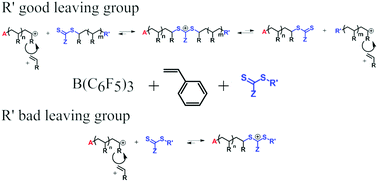“Living” cationic polymerization techniques based on reversible termination of propagating carbocations have been known for a number of decades but more recently degenerative chain transfer systems have been reported for the controlled polymerization of a number of monomers including vinyl ethers and p-methoxystyrene. In this work we demonstrate that when applied to the cationic polymerization of styrene, thiocarbonylthio compounds can lead to a dual control mechanism, where degenerative chain transfer occurs concurrent with a reversible addition mechanism. Using a B(C6F5)3/ROH initiating system it is shown that the addition to the thiocarbonylthio compound coupled with the high stability of the cationic intermediate allows for a limited degree of control directly, even in the absence of the degenerative transfer process, with the concentration of the alcohol initiator determining the molar mass. Unlike more stable carbocations formed from vinyl ethers and p-methoxystyrene, the dormant nature of the cationic intermediate formed in the presence of thiocarbonylthio compounds leads to a decrease in the rate of polymerization but can be used advantageously to induce control of polymerizations that employ efficient initiators.
